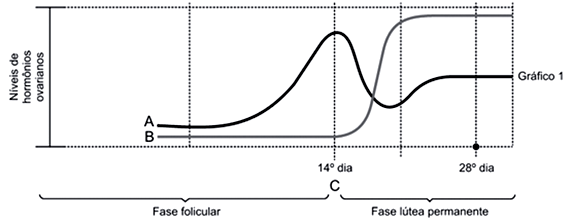O lixo pode sofrer uma série de transformações ao longo do tempo, nas quais se verificam mudanças em algumas características, tais como cheiro, cor e aparência. Ou seja, o conjunto final de características do material depois da transformação será diferente do conjunto inicial. A degradação de alimentos constitui um bom exemplo desse processo. Não há dúvida de que as características de um alimento mudam depois que ele estraga.
O texto anterior se refere a uma
Questões relacionadas
- Biologia | 9.4 Fisiologia Vegetal
Considere o seguinte experimento:
Um experimento simples consiste em mergulhar a
extremidade cortada de um ramo de planta de flores com pétalas brancas em uma solução colorida. Após algum tempo, as pétalas dessas flores ficarão coloridas.
(Sergio Linhares e Fernando Gewandsznajder. Biologia hoje, 2011.)
Considere os mecanismos de condução de seiva bruta e seiva elaborada nos vegetais. Nesse experimento, o processo que resultou na mudança da cor das pétalas é análogo à condução de
- Língua Inglesa | 1.4 Reading Strategies
“Culture is language”: why an indigenous tongue is thriving in Paraguay
Paraguayan Guaraní – a language descended from several indigenous tongues – remains one of the main languages of 70% of Paraguay’s population.
On a hillside monument in Asunción, a statue of the mythologized indigenous chief Lambaré stands alongside other great leaders from Paraguayan history. The other historical heroes on display are of mixed ancestry, but the idea of a noble indigenous heritage is strong in Paraguay, and – uniquely in the Americas – can be expressed by most of the country’s people in an indigenous language: Paraguayan Guaraní. “Guaraní is our culture – it’s where our roots are,” said Tomasa Cabral, a market vendor in the city.
Elsewhere in the Americas, European colonial languages are pushing native languages towards extinction, but Paraguayan Guaraní – a language descended from several indigenous tongues – remains one of the main languages of 70% of the country’s population. And unlike other widely spoken native tongues – such as Quechua, Aymara or the Mayan languages – it is overwhelmingly spoken by non-indigenous people.
Miguel Verón, a linguist and member of the Academy of the Guaraní Language, said the language had survived partly because of the landlocked country’s geographic isolation and partly because of the “linguistic loyalty” of its people. “The indigenous people refused to learn Spanish,” he said. “The imperial governors had to learn to speak Guaraní.” But while it remains under pressure from Spanish, Paraguayan Guaraní is itself part of the threat looming over the country’s other indigenous languages. Paraguay’s 19 surviving indigenous groups each have their own tongue, but six of them are listed by Unesco as severely or critically endangered.
The benefits of speaking the country’s two official languages were clear. Spanish remains the language of government, and Paraguayan Guaraní is widely spoken in rural areas, where it is a key requisite for many jobs. But the value of maintaining other tongues was incalculable, said Alba Eiragi Duarte, a poet from the Ava Guaraní people. “Our culture is transmitted through our own language: culture is language. When we love our language, we love ourselves.”
COSTA, W. Disponível em: www.theguardian.com. Acesso em: 3 set. 2020 (adaptado).
De acordo com o texto, um dos motivos da popularidade da língua guarani no Paraguai deve-se à (ao)
- Língua Espanhola | 2. Gramática
La vida en el Amazonas, ¿cuál es el estado actual de este hábitat natural?
- História - Fundamental | 05.3. Registros da história: a nossa cultura
O que foi o movimento das Diretas Já?
- Biologia | 11.9 Sistema Reprodutor
(UESB)
 O gráfico representa a variação de dois hormônios sexuais femininos ao longo de um ciclo menstrual em que ocorre uma gravidez.A análise do gráfico permite identificar as letras A, B e C como, respectivamente:
O gráfico representa a variação de dois hormônios sexuais femininos ao longo de um ciclo menstrual em que ocorre uma gravidez.A análise do gráfico permite identificar as letras A, B e C como, respectivamente: